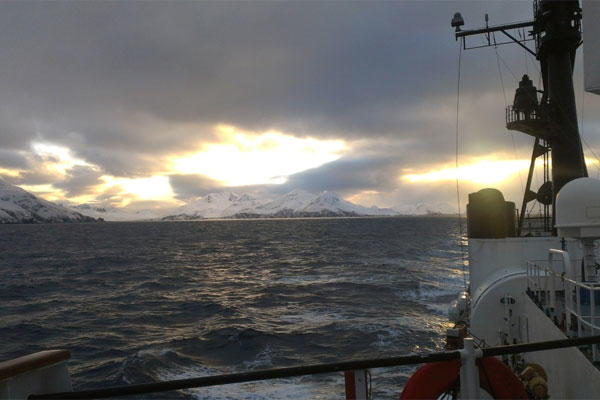In 1867 the U.S. Revenue Cutter Service, predecessor service to the U.S. Coast Guard, transported the first federal officials to the territory of Alaska. From this modest beginning, cutters would eventually sail into the Arctic and the Bering Sea to protect the sea and those on it. Thus, “The Bering Sea Patrol” was born.
Today, Coast Guard men and women continue to sail the Bering’s frigid waters, from Akutan to the Pribilofs. It takes a certain type of sailor to perform operations in these waters; Petty Officer 3rd Class Michael Valdes is one such Coast Guardsman.
Valdes was aboard Coast Guard Cutter Munro for their most recent Bering Sea patrol. As Munro steamed nearly 10,000 miles of tracklines in the Bering Sea, the cutter was called to save seven lives and to render critical transport and medical assistance to three others.
Valdes’ operational excellence is important in a place like the Bering Sea. A place where there is no room for shortcuts and little room for error. This was seen firsthand when Valdes and his shipmates responded to a radio call from fishing vessel Nordic Fury. A fisherman’s hand had been partially crushed attempting to free a net fouled in the vessel’s screws.
Valdes was the coxswain aboard Munro’s rescue boat dispatched to retrieve the fisherman. He skillfully maneuvered the boat in ice-cold chop to get the fisherman safely aboard Munro for medical attention.
“BM3 Valdes has a drive to succeed that few can match,” said his supervisor, Petty Officer 1st Class Ben Conner. “Along with his enthusiastic attitude, BM3 is always positive and easily spreads it to those all around him. He will certainly go far as a boatswain’s mate and as a leader.”
Valdes was part of Munro’s other successes on deployment as well. The cutter conducted more than a dozen safety boardings in unforgiving seas and biting Arctic winds, enforcing fisheries regulations and ensuring a fair catch and the safest possible working environment in America’s most hazardous fishery.
Throughout their 64-day patrol, Munro’s training teams administered 211 drills, honing the crew’s readiness in all areas of operation from fighting fires and flooding to launching helicopters and small boats.
When not responding to emergent operations, Valdes helped shape the future of the service. Charged with the supervision of 10 non-rates, he continuously worked to motivate and inspire his subordinates to perform arduous maintenance on an aging ship. Due to Valdes and other mentors aboard Munro, 79 watch station qualifications were achieved on their most recent patrol.
“BM3 Valdes is someone that I trust and I’m grateful to work for. Each time he and I work together, I’m confident he will teach me the correct way to get things done,” said Seaman Zack Draim. Draim worked with Valdes to complete his requirements for advancement to the next step in his career.
As early as next patrol, Munro’s junior personnel will be the ones responsible for the navigation, propulsion, engineering maintenance, operational support, damage control and steering of the 3,300-ton cutter; some of them as young as 18. Valdes assisted these shipmates, focusing specifically on proficiency in all they do.
“BM3 Valdes is a great shipmate and the number one person who helped me strike boatswain’s mate. If it wasn’t for him dedicating so much time to help me strike, I would not have advanced,” said Petty Officer 3rd Class Alexander Donoso who advanced earlier this month.
With another patrol complete, Munro’s crew turns to an intense dockside period in preparation for what lies ahead. Soon, they will set sail for another patrol; another opportunity to continue a long history of service in the Bering Sea.
With contributions from Lt. j.g. Drew Cavanaugh





























